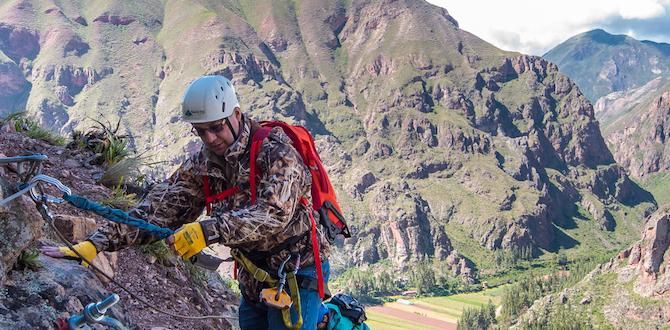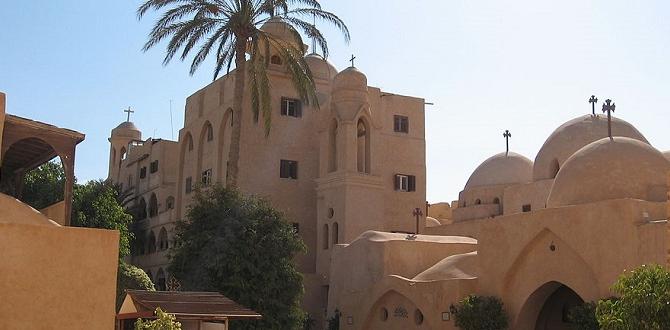Plan your Beirut shoulder season trip with ease! This guide offers practical tips for enjoying pleasant weather, fewer crowds, and great value in Lebanon’s vibrant capital during spring and autumn.
Planning a trip to Beirut can feel a bit overwhelming, right? You want to experience the city’s magic without the peak season hustle or the scorching summer heat. That’s where the shoulder seasons – spring and autumn – come in! These times offer a sweet spot for travelers.
Imagine sun-drenched days perfect for exploring, comfortable evenings, and a chance to truly connect with local life. This guide is your straightforward plan to unlock Beirut’s charm during its most delightful months, making your travel stress-free from start to finish. We’ll cover everything you need to know to make your Beirut adventure unforgettable!
Why Beirut in the Shoulder Season?
Beirut is a city that buzzes with energy year-round, but visiting during its shoulder seasons – typically April to May and September to October – offers a distinct advantage. These periods aren’t just about avoiding the crowds; they’re about experiencing the city at its most comfortable and authentic.
Pleasant Weather for Exploration
Forget about sweltering heat or biting winds. Beirut’s shoulder seasons boast mild, sunny days that are perfect for exploring. The average temperatures are inviting, making it ideal for:
- Wandering through historic neighborhoods like Gemmayzeh and Mar Mikhael.
- Relaxing at beachfront cafes along the Corniche.
- Visiting historical sites such as the National Museum of Beirut and the Roman Baths without breaking a sweat.
- Enjoying al fresco dining experiences and rooftop bars.
Spring brings blooming flowers and a refreshing breeze from the Mediterranean, while autumn offers warm sunshine with cooler evenings, perfect for enjoying the city’s vibrant nightlife.
Fewer Crowds, More Authenticity
During the peak summer months, Beirut can be a popular destination for both international tourists and diaspora returning home. Traveling in the shoulder season means you’ll encounter fewer tour groups and long queues. This translates to:
- More intimate experiences at popular attractions.
- Easier access to local restaurants and cafes.
- A more relaxed pace for sightseeing and exploration.
- Increased opportunities to interact with locals and get a genuine feel for daily life.
Better Value for Money
While Lebanon’s economy is dynamic, visiting during the shoulder season can often lead to more affordable travel. You might find:
- Lower prices on flights and accommodation compared to the peak summer months.
- Special offers or packages from hotels and tour operators.
- More room for negotiation on certain services or purchases.
This allows you to stretch your travel budget further, perhaps indulging in more delicious Lebanese cuisine or purchasing unique souvenirs.
When Exactly Are the Shoulder Seasons in Beirut?
Pinpointing the exact months can vary slightly based on weather patterns, but generally, the shoulder seasons are:
- Spring: April and May. This is when the city shakes off the winter chill and bursts into bloom. Expect daytime temperatures in the comfortable mid-20s Celsius (70s Fahrenheit) and pleasant evenings.
- Autumn: September and October. Following the intense summer heat, autumn offers a welcome respite with warm, sunny days and cooler evenings. Temperatures usually hover in the mid-20s to low 30s Celsius (70s to low 80s Fahrenheit) during the day, cooling down nicely at night.
The periods just before and after these shoulder months can also offer good conditions, so it’s always worth checking the weather forecast closer to your travel dates.
Your Beirut Shoulder Season Trip Plan: Step-by-Step
Let’s break down how to plan your perfect Beirut trip. This plan focuses on ease, comfort, and making the most of your visit. As a traveler who values practicality, I know that a clear roadmap makes all the difference.
Step 1: Define Your Travel Dates & Duration
Decide on your preferred shoulder season (spring or autumn) and how long you want your trip to be. A week is often a good starting point for Beirut, allowing you to see the highlights without feeling rushed. Longer stays will give you more time to explore beyond the city center.
Step 2: Book Your Flights and Accommodation
Flights: Start looking for flights a few months in advance, especially if you’re traveling from further afield. Consider the time of day you’ll arrive and depart. If you’re traveling with family or have specific comfort needs, arriving during daylight hours can be less stressful. For longer flights, especially if you or a family member requires them, ensure you have adult or child diapers readily available for maximum comfort and peace of mind. Reputable brands offer discreet and highly absorbent options for worry-free travel.
Accommodation: Beirut offers a range of options, from boutique hotels in trendy neighborhoods like Gemmayzeh and Mar Mikhael to more established hotels in the Hamra or Downtown areas. Consider what’s important to you: proximity to sights, quiet surroundings, or specific amenities. Booking in advance during the shoulder season will help secure the best rates and availability.
Step 3: Create a Flexible Itinerary
Don’t overschedule yourself! Beirut is a city to be savored. Here’s a template for a balanced itinerary:
Sample 7-Day Beirut Itinerary (Shoulder Season)
| Day | Morning Activity | Afternoon Activity | Evening Activity |
|---|---|---|---|
| Day 1 | Arrive, check into hotel. Settle in. | Explore Downtown Beirut (Place de l’Étoile, Roman Baths, National Museum). | Dinner in Gemmayzeh, enjoy the lively atmosphere. |
| Day 2 | Visit Beit Ed-Dine Palace (day trip). | Explore the beautiful surrounding gardens and local crafts. | Return to Beirut. Casual dinner in Hamra. |
| Day 3 | Walk the Corniche, visit Pigeon Rocks (Raouché). | Explore Hamra Street for shopping and cafes. | Sunset drinks at a rooftop bar overlooking the Mediterranean. |
| Day 4 | Day trip to Byblos (Jbeil) – ancient Phoenician city. | Explore the old souk, marina, and castle. | Enjoy fresh seafood dinner by the harbor in Byblos before returning. |
| Day 5 | Explore Mar Mikhael neighborhood (street art, galleries, boutiques). | Visit Achrafieh and the Sursock Museum. | Explore the vibrant nightlife in Mar Mikhael. |
| Day 6 | Relaxed morning, perhaps a visit to a local park or café. | Hike in the Chouf Mountains (e.g., Barouk Forest) if weather permits, or a cooking class. | Farewell dinner at a restaurant of your choice. |
| Day 7 | Last-minute souvenir shopping. Enjoy a final Lebanese breakfast. | Depart from Beirut. | N/A |
Remember to adapt this to your interests and energy levels. If you’re traveling with young children, factor in more downtime and child-friendly activities. For those managing continence needs, having a discreet supply of adult or child diapers can significantly reduce stress, allowing everyone to focus on the experience rather than potential discomfort during excursions.
Step 4: Pack Smart for Comfort and Convenience
Packing for Beirut’s shoulder season is about layering and versatility. Remember that while days are pleasant, evenings can be cooler, especially by the sea.
Essential Packing List for Beirut Shoulder Season
- Clothing: Light layers like t-shirts, light sweaters or cardigans, a light jacket or blazer, comfortable walking shoes, a pair of slightly dressier shoes for evenings, long pants or skirts, and a modest outfit for visiting religious sites (shoulders and knees covered).
- Accessories: Sunglasses, a hat, a scarf (very versatile!), a reusable water bottle, and a daypack or crossbody bag.
- Essentials: Travel adapter, portable power bank, sunscreen, basic first-aid kit, and any personal medications.
- For Specific Needs: Consider packing travel-sized toiletries and, for those who need them, a discreet supply of adult or child diapers. Brands specializing in travel-friendly options offer comfort and absorbency, ensuring you remain confident and comfortable throughout your journey.
Step 5: Transportation in Beirut
Getting around Beirut is relatively straightforward:
- Taxis/Ride-sharing: Uber and Careem are widely available and offer a convenient way to travel. Regular taxis are also plentiful; agree on a fare before you start your journey or ensure the meter is used.
- Public Transport: Buses and service taxis (shared minibuses that follow set routes) are the cheapest options but can be confusing for first-time visitors.
- Walking: Many central areas and neighborhoods are walkable and best explored on foot.
If you plan on taking day trips to nearby historical sites or natural attractions, consider hiring a private driver or joining a small group tour for ease and efficiency.
Step 6: Stay Connected and Informed
Connectivity: Purchasing a local SIM card upon arrival at the airport or in the city is usually cost-effective for data and local calls. Wi-Fi is common in hotels and cafes. Ensure your phone is unlocked to accept a foreign SIM card.
Information: Stay updated on local news and any travel advisories. The U.S. Department of State provides comprehensive travel information for Lebanon. While this is an example from the U.S., check your own country’s foreign travel advice for the most relevant information.
Step 7: Embrace the Culture and Cuisine
Beirut’s culture is a vibrant tapestry of influences. Don’t be afraid to delve into it!
Must-Try Lebanese Foods:
- Mezze: A spread of small dishes like hummus, baba ghanoush, tabbouleh, fattoush, and kebbeh.
- Manakish: Flatbread often topped with za’atar, cheese, or meat – perfect for breakfast or a snack.
- Shawarma: Marinated and grilled meat, often served in a wrap or as a platter.
- Knafeh: A sweet cheese pastry soaked in syrup.
- Lebanese Breakfast: Think fresh bread, labneh (strained yogurt), eggs, and a variety of dips.
Engage with locals, try street food (from reputable vendors), and enjoy the warmth of Lebanese hospitality. This is where the real magic of Beirut unfolds.
Navigating Specific Travel Needs
As Michael C. Herrera of Journey Essentials, I always stress the importance of comfort and preparedness, especially for unique travel needs. For some travelers, managing continence is a part of their journey. Be it due to health reasons, long travel days, or simply for extra security, having reliable adult or child diapers can dramatically enhance comfort and confidence.
For Travelers Requiring Diapers:
Modern adult and child diapers are designed for discretion, comfort, and superior absorbency. When packing:
- Choose the Right Product: Look for brands that offer overnight absorbency for long journeys or discreet, slim-fit options for daytime wear. Features like odor control and breathable materials add to the comfort.
- Pack Sufficiently: It’s always better to have a few extra than to run out, especially if you’re unsure about local availability or brand quality in your destination.
- Travel-Friendly Packaging: Some brands offer smaller, sample packs or travel sizes, which can be convenient for shorter trips or if you want to try them out.
- Airport Security: If you are carrying a significant amount of diapers, consider keeping them in their original packaging. For added privacy, you can place them inside your checked luggage.
Discussions around these needs are often quiet, but for many, they are crucial for a stress-free travel experience. Knowing you have reliable personal care items allows you to focus on exploring Beirut’s wonders.
Top 5 Things to Do in Beirut’s Shoulder Season
To give you a taste of what awaits, here are some must-do activities that shine during the shoulder months:
- Explore Historic Beirut: Wander through the reconstructed downtown area, visit the Roman Baths, and immerse yourself in history at the National Museum of Beirut. The comfortable weather makes this exploration a delight.
- Stroll the Corniche & Raouché: Take a leisurely walk along the famous Corniche, a seaside promenade, and marvel at the iconic Pigeon Rocks (Raouché). The mild temperatures are perfect for an evening stroll as the sun sets.
- Day Trip to Byblos (Jbeil): Discover one of the oldest continuously inhabited cities in the world. Explore its ancient ruins, charming harbor, and medieval castle. The pleasant climate makes the journey and exploration enjoyable.
- Experience the Art & Nightlife of Gemmayzeh & Mar Mikhael: These vibrant neighborhoods come alive with trendy cafes, art galleries, boutiques, and buzzing bars. The cooler evenings are ideal for experiencing their lively atmosphere.
- Visit Beit Ed-Dine Palace: Take a day trip to this stunning 19th-century palace in the Chouf Mountains. Its intricate architecture and beautiful courtyards are best enjoyed when the weather is mild and sunny, avoiding the summer heat.
Budgeting for Your Beirut Shoulder Season Trip
Beirut can be a more affordable destination than many Western European cities, especially during the shoulder season. Here’s a breakdown of potential costs:
| Category | Estimated Daily Cost (USD) | Notes |
|---|---|---|
| Accommodation (Mid-range) | $80 – $150 | Per night, can vary. Hostels and budget hotels are cheaper. |
| Food (Mid-range dining) | $40 – $70 | Includes meals and some drinks. Eating local can be much cheaper. |
| Transportation (Local) | $10 – $20 | Taxis, ride-sharing within the city. Day trips will cost more. |
| Activities & Entrance Fees | $15 – $30 | Museums, historical sites, etc. |
| Miscellaneous (Shopping, extras) | $20+ | Souvenirs, coffee, tips. |
| Total Estimated Daily Budget | $165 – $290 | This is a mid-range estimate per person, excluding flights. |
These are estimates, and your actual spending will depend on your travel style. Always factor in a buffer for unexpected expenses. Researching current exchange rates for the Lebanese Lira (LBP) is also advisable, as it can fluctuate.
Frequently Asked Questions
Q1: What is the best time to visit Beirut for pleasant weather?
A1: The shoulder seasons, from April to May and September to October, offer the most pleasant weather. You’ll enjoy mild temperatures, sunshine, and comfortable evenings, perfect for sightseeing.
Q2: Is Beirut safe for tourists?
A2: Like any major city, it’s wise to be aware of your surroundings. Major tourist areas are generally safe. It’s advisable to stay informed about the local situation through your country’s foreign travel advisories and exercise common sense.
Q3: How should I dress in Beirut?
A3: Casual, comfortable clothing is fine for most situations. However, it’s respectful to dress modestly (covering shoulders and knees) when visiting religious sites. Lightweight layers are recommended for the shoulder season to adapt to changing temperatures.
Q4: How do I get around Beirut?
A4: Ride-sharing apps like Uber and Careem are convenient and widely used. Taxis are also readily available, but it’s best to agree on the fare beforehand. Many central areas are also walkable.




